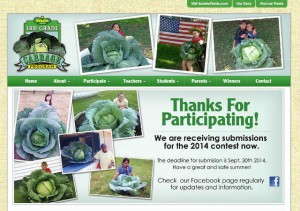“Social Media Is The New Garden Fence,” And Other Advice From Keynote Speaker P. Allen Smith At Cultivate’14
 Social media is not the enemy – it’s a tool that’s being used all over the world in many different markets to develop and engage the next generations of buyers. But when gardening guru P. Allen Smith asked the packed room full of Cultivate’14 attendees during his keynote address on July 13, how many of them are on Twitter, very few hands went up. A few more admitted they use Facebook. Ultimately, Smith said, the horticulture industry, as a whole, is not using social media enough – or at least, not effectively.
Social media is not the enemy – it’s a tool that’s being used all over the world in many different markets to develop and engage the next generations of buyers. But when gardening guru P. Allen Smith asked the packed room full of Cultivate’14 attendees during his keynote address on July 13, how many of them are on Twitter, very few hands went up. A few more admitted they use Facebook. Ultimately, Smith said, the horticulture industry, as a whole, is not using social media enough – or at least, not effectively.
Social Media Is The New Garden Fence
The most viewed television show in history was the series finale of M.A.S.H. in 1983, with 105.9 million viewers. While TV is still an effective medium, social media is rivaling its reach. Just this last year, 43 million viewers tuned in to watch the Oscars, but the selfie of hostess Ellen DeGeneres took at the Oscars with a few of her famous friends reached 37 million people within four hours.
“Social media is now the new garden fence over which we are sharing information,” Smith said.
Social media reaches buyers of many different ages, from the greatest generation to toddlers, he said. Check out some of the numbers he provided during his talk:
Greatest Generation:
- 77 percent have mobile devices
Baby Boomers:
- Wealthiest generation, representing 50 percent of all consumer packaging goods dollars.
Gen X: 1965-1980
- 70 percent are college educated
- 74 percent have kids
- 82 percent are homeowners
- More frugal than Boomers and Gen Y
Millenials (Gen Y): 1981-2000
- 90 million strong
- Next five years will have more spending power than any generation
- Digital generation
- Research products online before coming to the store
- Key is to market products with them, not to them
- Let millennials share their stories and experiences
- They trust in user-generated content
- Only 6 percent consider online ads to be credible
Boomlets (Gen Z): 2001 to present
- Oldest are 14, have cell phones and buying power
- True digital natives – they don’t know life without the Internet.
Who Is Our Consumer?
The new buyer demographics are changing. While Baby Boomers are our biggest buyers now, Smith said we need to consider generations X through Z as our future. Here are some interesting statistics about our target audience:
- 20 percent of homeowners are single women
- 4 in 10 women are sole or primary breadwinners
- More stay-at-home dads who like to do outdoor projects.
- College graduates who earn 75,000 plus per year, per household
- House-proud homeowners who have kids and pets
- Embedded generosity – interested in giving initiatives and social responsibility, like community gardens
These consumers are talking on social media, Smith said – are you listening?
- On Twitter, there are more than 1 billion tweets per week, amounting to 9,100 tweets per second.
- On Facebook, every 20 minutes: 1 million links are shared; 2 million people are friended; 3 million messages are created
- On YouTube, there are more than 6 billion hours of videos watched per month
- Pinterest is more popular than Twitter
- Facebook is aging, with 45 percent of users aged 65 and older
- Those who use instagram also use Twitter – there is a 50 percent crossover – you can use the two media together
- Pinterest and LinkedIn are stand-alone social media sites, not used with others
Fight For Your Audience
Smith implored AmericanHort membership to spend more time and resources on developing and creating an audience. “You have to fight for your audience. Is proper audience development a key marketing objective or an after thought,” he asked. “What if you reported audience growth and health to your investors, to your business partners or just to yourself?”
Like profits to your business’ bottom line, it’s important to think of audience development as an aspect of a healthy business.
“Numbers don’t matter as much as engagement and interest in what you’re promoting,” Smith said.
If you have a website, blog or social media presence, you would work with partners like other bloggers for content. Just make sure whatever you produce is mobile-friendly.
Offer ideas for how consumers can get involved in do-it-yourself (DIY) projects. For instance, Smith offered, consumers are wildly interested in food, especially locally grown, organic food, and want to know how to grow their own food.
“Consumers want to participate – you just have to engage them,” Smith said.
Urban homesteading is a new trend, as well.
“Young consumers want to learn how to do things their grandparents did,” he said. “We can teach them!”
Today’s consumers are also quite generous and want to share the bounty. Smith pointed to Bonnie Plants’ Third Grade Cabbage Program, which challenges third grade students to grow gardens and gives them cabbage seeds, to see who can grow the largest OS (oversized) cabbage. The winner gets a $1,000 scholarship and the kids love it.
Industry members should work with schools, and use social media to post photos of kids getting busy and working in the garden and being happy about it. By doing this, it gets parents excited and engaged in the project and in the schools.
Smith said today’s consumers are all about finding their bliss and “we are an industry that can help people feel good about themselves and their lives. If we contribute more to create a beautiful environment, help beautify cities and help bring beauty into consumers’ lives and show them how they can do that every day, we can help them improve the quality of their lives.”
After all, he said, “Dirt is the new Prozac.”









